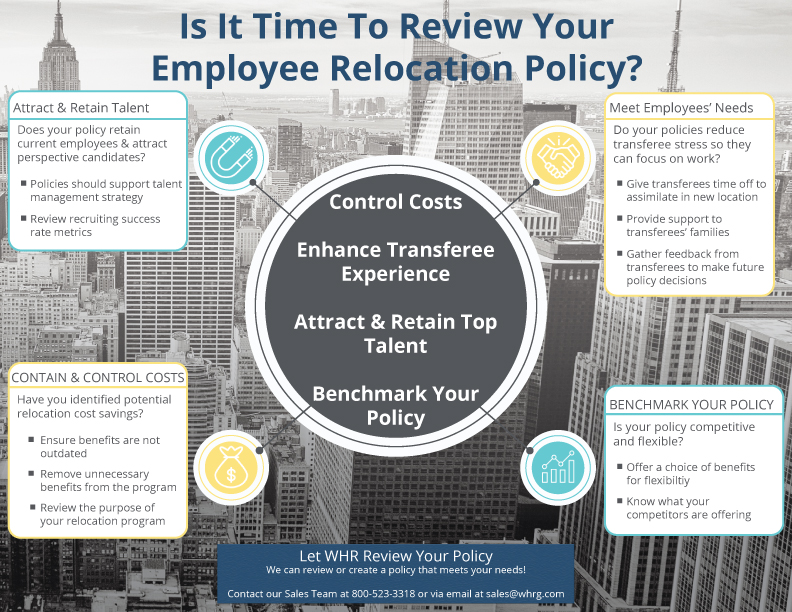Compte tenu des nombreux changements intervenus dans les entreprises depuis COVID-19, notamment en ce qui concerne le travail à distance, vous pensez peut-être qu'il n'y a aucune raison de revoir dès à présent la politique de relocalisation des salariés de votre entreprise. Détrompez-vous. De nombreuses entreprises déplacent encore des employés pour remplir des fonctions nécessaires. Le fait de revoir votre politique et d'y apporter les ajustements nécessaires dès maintenant peut aider votre entreprise dans les domaines suivants :
- Maîtriser les coûts de l'entreprise
- S'assurer que vous répondez aux besoins des employés
- Attirer et retenir les meilleurs talents
- Analyse comparative Votre politique par rapport à la concurrence
Les exemples suivants sont tirés de révisions de politiques menées par WHR Global pour ses clients. Ils montrent à quel point il est important de revoir régulièrement sa politique de relocalisation.
A. Maîtriser les coûts des entreprises et cesser de payer pour des avantages inutiles
Assurez-vous d'allouer le montant adéquat aux personnes transférées et aux besoins de l'organisation. Il est également essentiel de ne pas payer pour des avantages inutiles ou dépassés.
- Exemple 1
Uneentreprise dont nous avons examiné la politique donnait à chaque personne transférée une somme forfaitaire standard de 5 000 à 10 000 dollars pour la réinstallation afin de couvrir les dépenses supplémentaires. Elle accordait également aux cadres une somme forfaitaire égale à six semaines de salaire en plus de la somme forfaitaire de 5 000 à 10 000 dollars. Comme certains cadres avaient des salaires élevés, cette allocation équivalait parfois à 50 000 $ par cadre ! Après examen, nous avons recommandé à l'entreprise de réduire cette pratique pour les cadres. L'entreprise a économisé des centaines de milliers de dollars. - Exemple n° 2
Un client versait une indemnité de vie chère si l'employé déménageait dans une région où le coût de la vie est plus élevé. Il versait cette indemnité pendant 3 ou 4 ans et prévoyait également une indemnité forfaitaire importante. Nous avons recommandé un seuil minimum de 5 % pour le coût de la vie, afin de ne pas payer les personnes mutées dans des régions où le coût de la vie est à peine plus élevé. Le client a ainsi économisé des millions. - Exemple n° 3
Un autre client accordait des primes non promotionnelles aux employés actuels désireux de déménager pour occuper un poste latéral. Ces primes représentaient 5 % du salaire des employés. Cette pratique n'étant pas courante, nous lui avons recommandé de l'éliminer de sa politique de relocalisation, ce qui lui a permis d'économiser des coûts importants sans diminuer la valeur de son programme. - Exemple n° 4
L'un de nos clients payait une commission d'ouverture de dossier. Certains prêteurs ne facturent même pas ces frais, mais s'ils savent que le client les paiera, ils les factureront quand même. Lorsque le client s'en est rendu compte, il a cessé de payer ces frais, sauf en cas de nécessité.
B. Répondez aux besoins de vos employés
Il est important que votre politique de relocalisation réponde aux besoins des personnes transférées. Cela permet de réduire le stress des personnes transférées afin que les employés puissent se concentrer sur leur travail dans leur nouveau lieu de travail. Accorder aux personnes mutées des congés pour s'adapter à leur nouveau lieu de travail, apporter un soutien aux familles des personnes mutées et recueillir les réactions après la mutation pour prendre de futures décisions politiques sont autant d'éléments qui contribueront à répondre aux besoins de vos personnes mutées.
- Exemple n° 1
L'un de nos clients offrait une indemnité forfaitaire pour toutes les délocalisations internationales. En recueillant les retours d'enquête après la relocalisation, nous avons découvert que les personnes transférées essayaient de coordonner leurs propres envois d'articles ménagers internationaux et ne dépensaient pas la totalité de la somme forfaitaire, dans l'espoir de garder un peu d'argent. Les réponses à l'enquête ont également montré que le fait de donner ce niveau de choix aux employés augmentait leur stress et prolongeait le processus de relocalisation. En fait, les personnes mutées essayaient de tout faire par elles-mêmes et de faire des économies. Le client a examiné toutes les prestations clés et a déterminé que la somme forfaitaire ne fonctionnait pas. Il est passé d'une somme forfaitaire à une prestation flexible de base. Cela signifie que le client couvrirait les expéditions de marchandises lourdes, les fournisseurs de services de destination et le logement temporaire, mais qu'il donnerait toujours aux personnes transférées un montant forfaitaire à utiliser à la discrétion des employés. Cette mesure a permis non seulement de réduire le stress des personnes transférées, mais aussi de contrôler les coûts de l'entreprise.
- Exemple n° 2
Un client ne proposait pas de services de destination aux conjoints/partenaires et aux familles dans le cadre de déménagements intra-européens. Il supposait que si une personne transférée/famille déménageait de Russie au Royaume-Uni, par exemple, les services de destination n'étaient pas nécessaires. L'enquête menée après la relocalisation a révélé que les conjoints/partenaires avaient besoin d'une assistance professionnelle, d'une formation linguistique et d'une aide pour la recherche d'une école pour leurs enfants. L'employé disposait d'employés de bureau pour l'aider à s'adapter à son nouveau lieu de travail, mais les partenaires des personnes transférées se débattaient avec la nouvelle langue et avaient même du mal à trouver des produits de première nécessité, comme des épiceries. Il est essentiel de reconnaître les besoins de l'ensemble de la cellule familiale, et pas seulement ceux de la personne mutée, pour garantir la réussite du déménagement et de l'assimilation.
C.Attirer et retenir les talents et comparer votre politique avec celle de la concurrence
Avec un peu de chance, votre politique de relocalisation fait déjà partie de votre stratégie de rémunération globale et de gestion des talents. Une politique appropriée aidera votre entreprise à conserver ses employés actuels et à attirer des candidats potentiels. Une politique de relocalisation insuffisante pourrait avoir un impact négatif sur le taux de réussite de votre recrutement.
L'évaluation de votre politique par rapport à d'autres entreprises vous aidera à rester compétitif dans la guerre des talents. Veillez à ce que votre politique offre un choix d'offres, car les politiques de relocalisation sont intégrées dans les offres d'emploi. Si vous ne vous comparez pas à vos concurrents, vous ne saurez pas si vos offres sont bonnes ou non. Sont-elles inférieures à celles des autres ? Si vous recrutez des cadres de haut niveau, par exemple, et que le talent est très spécifique et difficile à trouver, vous devez vous assurer que vous êtes compétitif en termes de salaire, d'avantages sociaux et de politique de relocalisation.
En même temps, l'analyse comparative vous permettra de vous assurer que vous ne donnez pas trop, alors qu'aucun de vos concurrents ne le fait. L'évaluation comparative de votre politique par rapport à d'autres montre que vous êtes en phase avec le secteur. Il est également important d'examiner non seulement votre secteur, mais aussi les autres secteurs avec lesquels vous êtes en concurrence pour les talents.
- Exemple n° 1
Imaginez que vous perdiez un candidat potentiel parce que votre politique de relocalisation ne comprend pas les avantages offerts par vos concurrents. Par exemple, si votre candidat est un cadre qui s'attend à un rachat complet, mais que votre politique ne prévoit qu'un déménagement HHG et une indemnité forfaitaire, vous devrez alors négocier avec vos supérieurs et le candidat. Cela peut vous faire perdre beaucoup de temps. Dans l'intervalle, le candidat pourrait recevoir une meilleure offre d'emploi, comprenant davantage d'avantages liés à la relocalisation. La politique de relocalisation peut être un facteur déterminant pour les candidats qui décident d'accepter un emploi plutôt qu'un autre. Si vous avez comparé votre politique à celle de vos concurrents, vous savez déjà ce qu'elle comprend.
- Exemple n° 2
Unclient recevait des commentaires de son équipe d'acquisition de talents selon lesquels il était difficile de pourvoir certains postes. Après avoir examiné leur politique et l'avoir comparée à celle de leurs concurrents, nous avons découvert que ces derniers offraient des avantages de réinstallation bien plus importants. En conséquence, l'entreprise a décidé d'élargir sa gamme de postes donnant droit à des avantages complets en matière de réinstallation.
D. À quelle fréquence devez-vous revoir votre politique ?
WHR vous recommande de revoir votre politique de réinstallation des employés chaque année ou au plus tard tous les deux ans. Il n'est pas nécessaire de procéder à une révision en profondeur, mais c'est l'occasion pour vous de faire une pause et d'examiner les commentaires des employés. En outre, vous devez confirmer tout changement dans la culture de votre entreprise, ses principes directeurs, ses valeurs fondamentales, sa stratégie en matière de talents, son secteur d'activité et sa concurrence. La révision est l'occasion de s'assurer que votre politique est alignée sur tous ces éléments et sur vos principales parties prenantes (équipes d'acquisition des talents, équipes de recrutement, partenaires commerciaux des RH).


